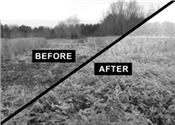|
Disking Can Improve Wildlife Food, Habitats

Light disking from October through March is effective for seed germination and new plant growth
during the next growing season.
Photos by MSU Forest and Wildlife Research Center/Wes Burger
STARKVILLE, MISS.
Thinning timber, prescribed fire and planting wildlife food plots are the most common tools in wildlife management, but there is another, often overlooked practice: using light disking to disturb the soil.
Disking is a cost-effective practice generally available to landowners and land managers. Much like prescribed fire, disking can be used to set back plant succession of old fields and openings. It reduces perennial plant growth and encourages annual plant growth and diversity, which is beneficial for wildlife.
Disking to mimic soil disturbance and manage plant communities does not need to be as deep as when you prepare a seed bed for planting. A light disking 3 to 5 inches deep is effective for seed germination and new plant growth.
The best method is strip disking, which works well with old fields and stands of open timber. Strip disking is done in 10- to 15-foot-wide strips, leaving alternating undisturbed strips in between. The undisturbed strips are equal to or double the width of the disked strips. This method allows for establishing a rotational pattern of soil disturbance on a two- to three-year rotation.
Another method is alternate-patch disking, which is more suitable for long, narrow openings, such as road and utility rights-of-way. It’s the same principle as strip disking, but you leave alternating undisturbed patches of the same size between disked areas.
Conduct strip disking and alternate-patch disking from October through March. Fall disking encourages growth of native legumes (partridge pea, beggar weed), other broadleaf annuals (croton, ragweed) and large-seeded grasses.
The purpose of leaving undisturbed strips and patches is to create uneven-aged plant communities on a rotational basis. You can leave strips or patches of 1-, 2-, and 3-year-old plant communities next to one another across a field or opening. This pattern is especially beneficial to smaller, ground-nesting birds like quail because it maintains nesting and brood-rearing cover all together.
New growth of annual broadleaf plants provides deer and turkeys with nutrient-rich forage. In addition, lush green growth attracts insects and creates “bugging” areas for turkeys, quail and some songbirds. Insects are a much-needed source of protein for eggshell development.
By mid- to late summer, growth of native legumes and broadleaf weeds from the previous fall disking have transitioned to closed canopy with open ground underneath. These areas provide excellent brood-rearing habitat for turkeys and quail. The canopy provides cover from aerial predators, while the open ground allows young turkey poults and quail chicks to maneuver underneath and feed. In late fall and early winter, seed from mature plants in these previously disked strips provide quail and many other birds with an important food source.
Strip disking and alternate-patch disking are excellent methods for managing old fields and openings. These methods not only prevent such areas from transitioning to woodlands, but also manage the vegetation in a way that maximizes benefits for wildlife.
For more information on the benefits of disking for wildlife, see USDA-NRCS Technical Note No. 190–32, “Light Disking to Enhance Early Successional Wildlife Habitat in Grasslands and Old Fields: Wildlife Benefits and Erosion Potential,” or Mississippi State University Extension Publication 2179, “Ecology and Management of the Northern Bobwhite.”
Contact Bronson Strickland, wildlife specialist at MSU Extension Service, for more information.
Editor’s Note: Extension Outdoors is a column authored by several different experts in the Mississippi State University Extension Service. ∆
|
|